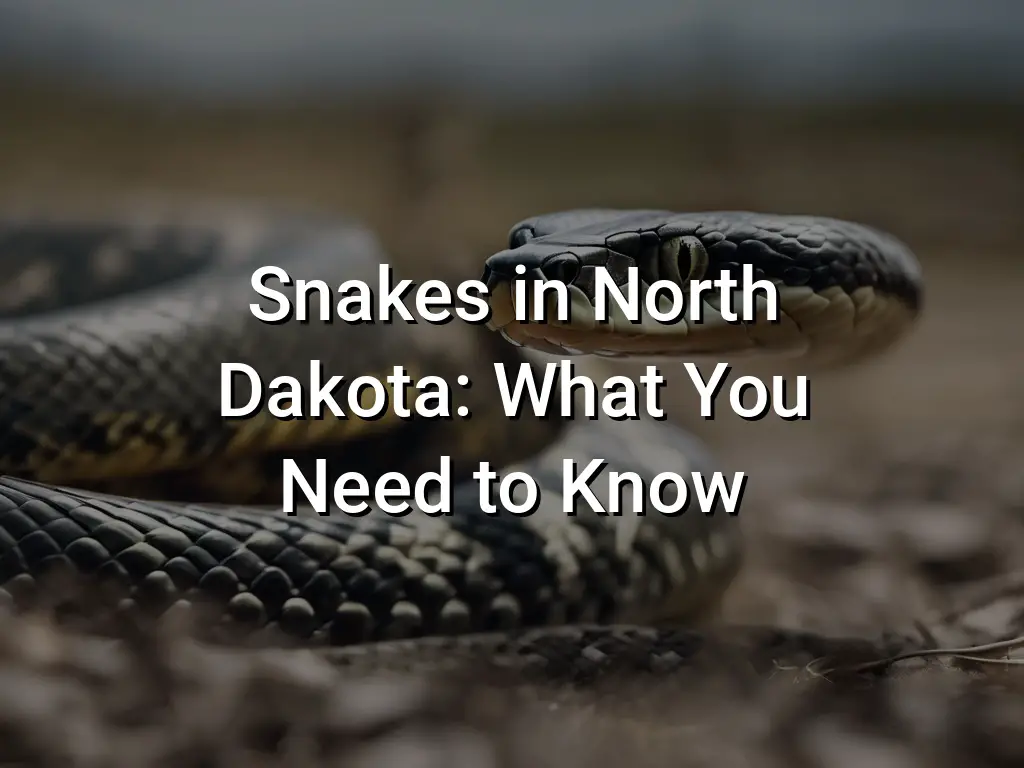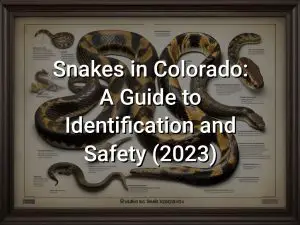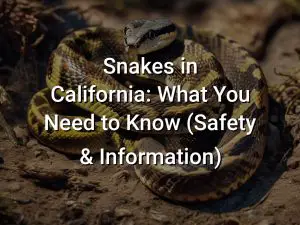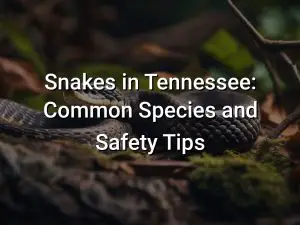Snakes in North Dakota: What You Need to Know

Snakes in North Dakota: What You Need to Know
North Dakota may not be the first place that comes to mind when you think of snakes, but these slithering creatures do call the state home. From the types of snakes you might encounter to snakebite first aid and educational resources, this article covers everything you need to know about snakes in North Dakota.
Quick Links
Types of Snakes in North Dakota
North Dakota is home to a variety of snake species, each with its own unique characteristics and habits. Here are some of the snakes you may encounter in North Dakota:
- 1. Western Hognose Snake (Heterodon nasicus): This snake is known for its upturned nose and defensive behaviors, such as playing dead and hissing. It is typically found in grasslands and prairies.
- 2. Plains Garter Snake (Thamnophis radix): This common snake has a long and slender body with stripes running along its back. It can be found in a variety of habitats, including wetlands and meadows.
- 3. Bullsnake (Pituophis catenifer sayi): A larger snake, the bullsnake is known for its impressive size and patterned scales. It is often mistaken for a rattlesnake due to its similar coloration and behavior of vibrating its tail when threatened.
- 4. Prairie Rattlesnake (Crotalus viridis): The only venomous snake species in North Dakota, the prairie rattlesnake can be identified by its distinctive rattling tail. It is typically found in rocky areas and grasslands.
- 5. Smooth Green Snake (Opheodrys vernalis): This slender and bright green snake is non-venomous and commonly found in grassy habitats. It is known for its calm and docile nature.
While these are some of the snakes you may encounter in North Dakota, it’s important to remember that the majority of snake species in the region are non-venomous and play a valuable role in maintaining ecosystem balance. It is always recommended to observe snakes from a safe distance and avoid handling or disturbing them.
Snake Habitats in North Dakota
North Dakota is home to a diverse range of habitats that provide suitable environments for snakes to thrive. Snakes in North Dakota can be found in a variety of habitats, including grasslands, prairies, forests, wetlands, and even urban areas.
Grasslands and prairies are common habitats for many snake species in North Dakota. These open areas provide ample opportunities for snakes to bask in the sun, hunt for prey, and find shelter. Garter snakes, bullsnakes, and western hognose snakes are frequently found in grassland and prairie habitats.
Forests, particularly those along river valleys, also serve as important snake habitats in North Dakota. Eastern rat snakes, eastern garter snakes, and smooth green snakes are often found in these wooded areas. Snakes in forest habitats rely on the availability of suitable prey and hiding places, such as fallen logs and leaf litter.
Wetlands, including marshes, swamps, and ponds, are attractive habitats for certain snake species. Water snakes, such as the northern water snake and the common garter snake, can be found near bodies of water in North Dakota. These snakes are not venomous and are typically harmless to humans.
Urban areas in North Dakota also provide habitats for snakes, although encounters with snakes in these areas are relatively uncommon. Snakes may seek shelter in gardens, under rocks, or in other protected areas. It is important for residents to be aware of snakes in urban areas and to take precautions to ensure their own safety.
It is worth noting that while snakes can be found in various habitats throughout North Dakota, they generally prefer areas with suitable cover, food sources, and access to water. Understanding the different types of snake habitats in North Dakota can help residents and visitors make informed decisions when it comes to snake encounters and habitat preservation.
Snake Behavior and Characteristics
Snakes are fascinating creatures that play an important role in North Dakota’s ecosystems. Understanding their behavior and characteristics can help residents coexist with these reptiles and ensure their safety. Here are some key things to know:
- Slithering Movement: Snakes move by slithering, using their scales and muscles to propel themselves forward. They can move quickly and quietly, making them difficult to spot in their natural habitats.
- Cold-Blooded: Snakes are ectothermic, meaning they rely on external sources of heat to regulate their body temperature. They bask in the sun to warm up and seek shade or burrows to cool down.
- Non-Aggressive: Most snake species in North Dakota are non-aggressive and will only bite if they feel threatened. They prefer to avoid confrontation and will typically retreat if given the opportunity.
- Camouflage: Snakes have evolved to blend in with their surroundings, allowing them to hide from predators and ambush prey. Their colors and patterns can vary greatly depending on the species and the environment they inhabit.
- Eating Habits: Snakes are carnivorous and feed on a variety of prey, including rodents, birds, frogs, and insects. They swallow their prey whole after capturing and immobilizing it with their venom (in venomous species) or constriction (in non-venomous species).
- Habitat Preferences: Different snake species have different habitat preferences. Some are found in grasslands, while others prefer wetlands or woodland areas. Understanding their preferred habitats can help residents avoid encounters.
Remember, snakes play an important role in controlling rodent populations and maintaining the balance of North Dakota’s ecosystems. It’s best to observe them from a distance and avoid disturbing or provoking them. If you encounter a snake, it’s always recommended to contact local wildlife authorities for assistance or to seek guidance from snake removal services.
Snake Safety Tips for North Dakota Residents
Living in an area with snakes can be concerning for some residents, but with the right knowledge and precautions, you can coexist safely with these reptiles. Here are some important snake safety tips for residents of North Dakota:
- Learn to identify the snakes in your area: One of the first steps in snake safety is being able to identify the different snake species in North Dakota. Familiarize yourself with their physical characteristics and markings to avoid any potential dangerous encounters.
- Give snakes their space: Snakes are generally not aggressive and will only strike if they feel threatened. Give them a wide berth and avoid provoking or handling them. Remember, snakes play an important role in the ecosystem and should be respected.
- Be cautious in snake habitats: Snakes are typically found in grasslands, woodlands, and wetland areas. When hiking or spending time outdoors, be aware of your surroundings and watch where you step or place your hands. Stick to designated trails to minimize the risk of encountering a snake.
- Use protective clothing and gear: If you are venturing into snake habitats, it is advisable to wear long pants, long sleeves, and closed-toe shoes or boots. Consider using snake-proof gaiters for added protection.
- Secure your property: To minimize the chances of snakes entering your property or home, seal any cracks or openings that snakes could crawl through. Keep your yard tidy by removing debris, woodpiles, and tall grass that can create hiding places for snakes.
- Be mindful of pets: Keep an eye on your pets when they are outside, especially in snake-prone areas. Dogs, in particular, can be curious and may inadvertently disturb or provoke a snake.
- Know what to do in case of a snake encounter: If you do come across a snake, stay calm and slowly back away. Do not attempt to handle or kill the snake, as this can increase the risk of a bite. If you or someone else is bitten, seek medical attention immediately.
- Educate yourself and others: Stay informed about snakes in your area and educate your family, friends, and neighbors about snake safety. The more everyone knows, the safer everyone will be.
By following these snake safety tips, you can minimize the chances of a snake encounter and ensure the safety of yourself, your family, and the snakes in North Dakota.
Snakebite First Aid
If you or someone you know is bitten by a snake in North Dakota, it is important to seek medical attention immediately. Snakebites can be dangerous and require prompt medical treatment. While waiting for medical help to arrive, there are a few steps you can take to provide initial first aid:
- Stay calm and try to keep the affected person calm as well. Panicking can increase heart rate and spread the venom faster.
- Keep the bitten area still and below heart level, if possible. This can help slow the spread of venom.
- Remove any tight clothing or jewelry near the bite site, as swelling may occur.
- Do not attempt to suck out the venom or use any kind of tourniquet. These methods are ineffective and can cause more harm.
- Clean the wound with soap and water, if available. This can help reduce the risk of infection.
- Apply a clean, sterile bandage or cloth to the wound. Avoid applying tight pressure, as this can restrict blood flow.
- Keep the person still and monitor their vital signs, such as breathing and heart rate, while waiting for medical help.
- Do not try to catch or kill the snake for identification purposes. Focus on getting medical help instead.
Remember, snakebite treatment should only be administered by medical professionals. It is important to get to a hospital as soon as possible for proper evaluation and treatment.
Conservation Efforts for North Dakota Snakes
Conservation efforts for North Dakota snakes are essential to protect and preserve these important members of the state’s ecosystem. Snakes play crucial roles in controlling rodent populations and maintaining the balance of natural habitats.
One of the main conservation efforts for North Dakota snakes is habitat preservation. Many snake species in the state rely on specific habitats, such as grasslands, wetlands, and forests. Protecting and restoring these habitats ensures that snakes have suitable areas to live, feed, and reproduce.
In North Dakota, organizations and agencies work to educate the public about the importance of snakes and their conservation. These efforts aim to dispel common myths and misconceptions about snakes, promoting understanding and appreciation for these creatures. By raising awareness, individuals and communities can become more supportive of snake conservation initiatives.
Another conservation effort for North Dakota snakes is the establishment of snake-friendly road mitigation practices. Snakes are often killed by vehicles while crossing roads, especially during their breeding season. By implementing measures such as wildlife underpasses and snake fencing along roadways, the risk of snake mortality can be reduced.
In addition to these initiatives, some snake species in North Dakota are protected by state and federal laws. These laws regulate activities such as hunting, collection, transportation, and trade of snakes, ensuring sustainable use and preventing overexploitation.
Conservation efforts also include monitoring snake populations through surveys, studies, and research. By understanding population dynamics, habitat requirements, and threats, conservationists can develop effective management strategies to safeguard snakes in North Dakota.
Ultimately, the combined efforts of government agencies, conservation organizations, researchers, and the public play a vital role in conserving North Dakota snakes. It is essential to respect and protect these creatures to maintain the ecological balance and biodiversity of the state.
Common Myths About Snakes in North Dakota
Snakes have long been the subject of myths and misconceptions, and North Dakota is no exception. Here are some common myths about snakes in North Dakota:
- Myth: All snakes in North Dakota are venomous.
Reality: While North Dakota is home to some venomous snakes, such as the Prairie Rattlesnake, not all snakes in the state are venomous. The majority of snakes in North Dakota are harmless and play a crucial role in the ecosystem. - Myth: Snakes are aggressive and will attack humans.
Reality: Snakes are generally shy and prefer to avoid humans. They will only bite as a last resort if they feel threatened or cornered. It’s important to give snakes their space and not provoke or try to handle them. - Myth: Snakes are slimy.
Reality: Snakes may appear smooth and shiny, but they are not slimy. Their scales are dry and help with their movement and protection. - Myth: Snake charming is possible.
Reality: The practice of snake charming, where a person plays music or uses other means to control snakes, is mostly a myth. Snakes lack external ears and are therefore not charmed by music. Instead, they may be responding to the movement of the charmer or the vibrations caused by the music. - Myth: Baby snakes are more dangerous than adult snakes.
Reality: Baby snakes are born with fully functional venom glands, but they are not inherently more dangerous than adult snakes. In fact, adult snakes are typically more experienced and better able to control the amount of venom they inject when they bite.
By understanding the truth behind these common myths, you can better educate yourself about snakes in North Dakota and coexist with them safely and responsibly.
Snake Removal Services in North Dakota
If you encounter a snake on your property in North Dakota and need assistance with its removal, there are professional snake removal services available to help. These experts are trained in handling and safely relocating snakes to ensure the safety of both the snake and humans.
Snake removal services in North Dakota offer a variety of services to homeowners and businesses, including:
- Snake Identification: Snake removal experts can identify the species of snake that you’ve encountered. This information can help determine the appropriate course of action.
- Snake Trapping: The removal team will use specialized techniques and equipment to safely trap the snake and secure it for removal.
- Snake Relocation: Once the snake is captured, it will be relocated to a more suitable habitat away from human-populated areas.
- Snake Prevention: Snake removal services can also provide advice on strategies to prevent future snake encounters, such as sealing entry points and removing attractants.
It’s important to remember that snakes play a vital role in the ecosystem and are generally beneficial for controlling rodent populations. However, if you feel threatened or have concerns about snakes on your property, contacting a professional snake removal service is the safest and most effective solution.
Snake-related Laws and Regulations in North Dakota
In North Dakota, there are certain laws and regulations in place regarding snakes and their ownership. It is important for residents to be aware of these laws to ensure the well-being of both snakes and the community.
One of the key laws in North Dakota is that it is illegal to possess venomous snakes without a permit. This is to protect public safety and prevent potential accidents or releases of venomous snakes into the wild. Venomous snakes are those species that possess venom that can be harmful or deadly to humans.
Another important regulation is the requirement for permits for the importation, possession, and exhibition of certain species of snakes. This is to prevent the introduction of non-native or invasive snake species and to ensure that individuals who possess and exhibit snakes have the necessary knowledge and facilities to properly care for them.
Additionally, it is important to note that some counties or municipalities in North Dakota may have their own specific regulations regarding snakes. It is advisable to check with local authorities or animal control agencies to be aware of any additional requirements or restrictions.
If you are interested in keeping snakes as pets in North Dakota, it is crucial to research and understand the laws and regulations in your area. This will help ensure that you are in compliance with the law and can provide appropriate care for your snake.
Educational Resources for Learning About Snakes in North Dakota
If you’re interested in learning more about snakes in North Dakota, there are several educational resources available to help you expand your knowledge. These resources provide valuable information about the types of snakes found in the state, their habitats, behavior, and conservation efforts. Here are some educational resources you can explore:
- North Dakota Game and Fish Department: Visit the North Dakota Game and Fish Department’s website for information about snakes in the state. They provide resources on identifying snakes, snake safety tips, and conservation efforts.
- Local Nature Centers and Museums: Many nature centers and museums in North Dakota offer educational programs and exhibits about snakes and other wildlife. Visit these facilities to learn from knowledgeable staff and see live snakes up close.
- Online Herpetology Courses: If you’re looking for a more in-depth educational experience, consider enrolling in online herpetology courses. These courses cover various aspects of snake biology, behavior, and ecology.
- Field Guides and Books: There are many field guides and books available that provide detailed information about snakes in North Dakota. These resources can help you identify different species, understand their natural history, and learn about their unique characteristics.
- Online Snake Identification Guides: Several websites offer online snake identification guides specifically for snakes found in North Dakota. These guides typically include photos, descriptions, and range maps to help you identify snakes you may encounter in the state.
By utilizing these educational resources, you can develop a better understanding of snakes in North Dakota and contribute to their conservation efforts. Remember to always approach snakes with caution and respect their natural habitats.
Conclusion
As you can see, there are several types of snakes found in North Dakota, each with their own unique habitats, behaviors, and characteristics. It’s important for residents of North Dakota to be knowledgeable about snakes in order to coexist with them safely and responsibly.
By following the snake safety tips provided, North Dakota residents can minimize the risk of snake encounters and handle any potential snakebite situations properly. Additionally, it’s essential to understand the importance of snake conservation and the role it plays in maintaining the ecological balance of the region.
Whether you are interested in learning more about snakes in North Dakota, need assistance with snake removal, or want to educate yourself on the laws and regulations surrounding snakes, there are resources available to help you. By fostering an understanding and respect for snakes, we can appreciate the unique role they play in our environment and ensure their continued existence in North Dakota.
Remember, with the right knowledge and precautions, we can coexist with snakes and appreciate the beauty and diversity of wildlife in our state. Stay informed, stay safe, and continue to learn about the fascinating world of snakes in North Dakota.






